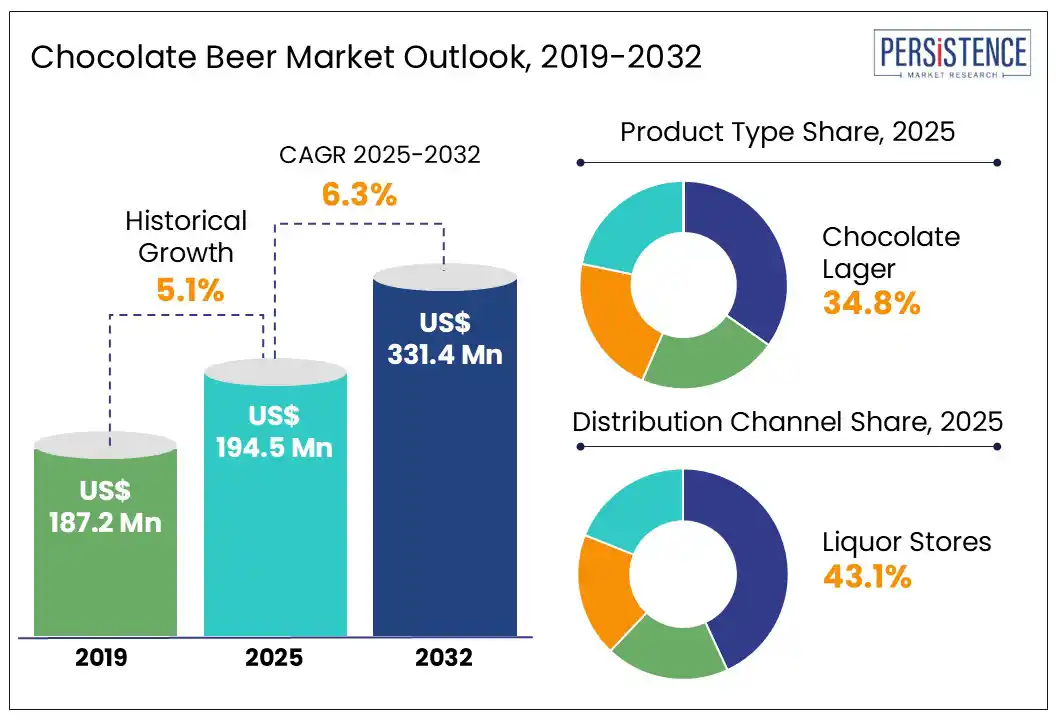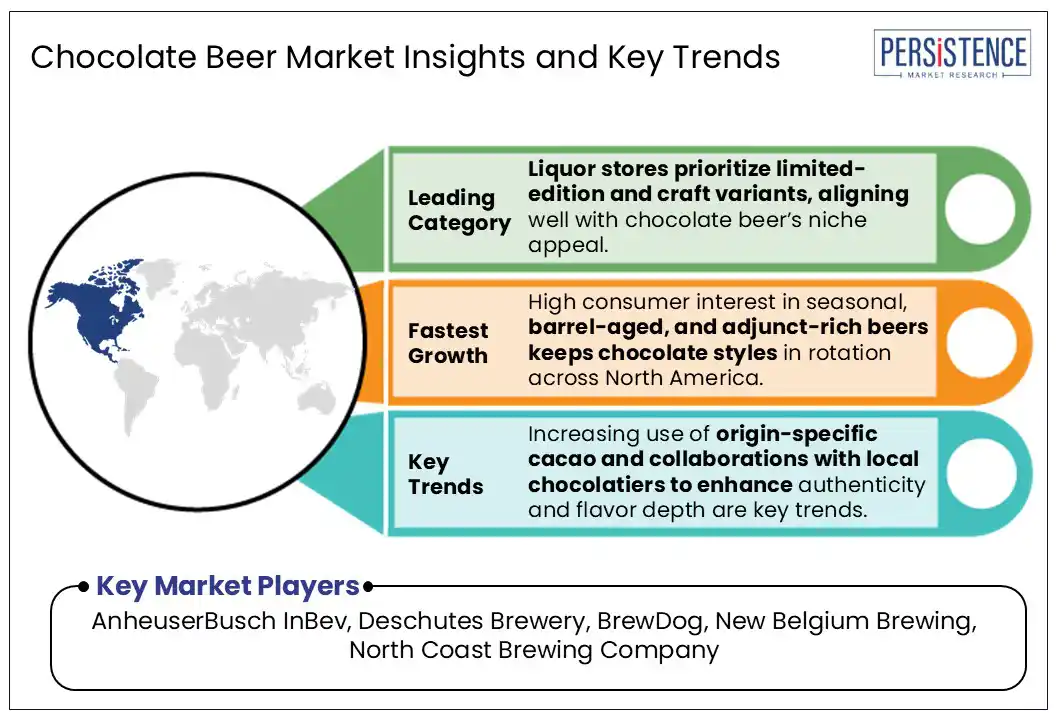ID: PMRREP35481| 180 Pages | 11 Jul 2025 | Format: PDF, Excel, PPT* | Food and Beverages

The global chocolate beer market size is likely to be valued at US$ 194.5 Mn in 2025 and is expected to reach US$ 331.4 Mn in 2032, growing at a CAGR of 6.3% during the forecast period 2025-2032.
Modern consumers are gravitating toward flavor-forward alcoholic beverages that deliver a memorable drinking experience, and chocolate beer fits this trend perfectly. Whether offered as a velvety stout, a dessert porter, or an artisanal ale, chocolate beer appeals to those looking for indulgent alternatives to traditional lagers. Its rising popularity reflects increasing shifts in consumer behavior toward premiumization and experiential consumption. For brands looking to expand their flavor portfolios or enter new demographics, this type of beer provides a compelling proposition backed by strong sensory appeal and surging consumer interest.

Key Industry Highlights
|
Global Market Attribute |
Key Insights |
|
Chocolate Beer Market Size (2025E) |
US$ 194.5 Mn |
|
Market Value Forecast (2032F) |
US$ 331.4 Mn |
|
Projected Growth (CAGR 2025 to 2032) |
6.3% |
|
Historical Market Growth (CAGR 2019 to 2024) |
5.1% |
The emergence of brewpubs is significantly pushing the chocolate beer market growth by enabling experimentation, hyper-local appeal, and seasonal product rotations catering to consumer curiosity. Brewpubs operate with agile production setups that allow rapid prototyping of niche styles such as chocolate stouts, cocoa-infused porters, and dessert ales. They often capitalize on event-based marketing, pairing chocolate beers with curated food menus, which boosts onsite consumption and engagement.
Brewpubs also utilize customer feedback loops, either through loyalty apps or tasting sessions, to refine chocolate and wheat beer recipes in real-time. It has led to region-specific flavor innovations, including dark chocolate and coconut ale, in Southeast Asia or white chocolate and lavender beer lines in boutique pubs across Seoul. The localized, fresh-from-the-tap model creates a premium, small-batch appeal that packaged retail options struggle to match. As brewpubs expand in Tier-1 and Tier-2 cities globally, demand for chocolate beer is expected to rise.
The potential for gastrointestinal discomfort limits the consumption of chocolate beer to a certain extent, especially among the population with sensitivities to rich or adjunct-heavy brews. Chocolate beers often contain high levels of roasted malts, lactose, and added cocoa or chocolate syrups. These often trigger digestive issues such as bloating, acid reflux, or mild nausea in sensitive individuals. As per a 2023 consumer insights report on flavored alcoholic beverages, around 12% of surveyed consumers in North America cited digestive unease as a reason for avoiding dark or dessert-style beers.
The problem is more pronounced with high-ABV chocolate stouts and porters, which are usually dense in both calories and fermentable sugars. In addition, individuals with lactose intolerance often steer clear of milk chocolate stouts due to the presence of unfermented lactose, which the brewing yeast cannot process. Breweries are slowly responding with lactose-free or vegan alternatives, but the segment remains small.
The emergence of sustainable packaging solutions such as biodegradable cans and compostable labels is creating unique branding and market expansion opportunities. Several niche breweries producing chocolate beer are using sustainability as a differentiator in a crowded craft market. In the recent past, Young Henrys Brewery in Australia, for example, partnered with PakTech to launch a chocolate stout packaged with 100% recycled and recyclable handles as well as trialed biodegradable can liners made from plant-based polymers. In the U.S., Almanac Beer Co., known for its small-batch specialty beers, moved to fully compostable six-pack holders and printed cans with eco-friendly soy inks. This eco-packaging strategy allowed them to secure shelf space in sustainable grocery outlets such as Thrive Market and Natural Grocers. These innovations are expected to help brands comply with the purchasing behavior of Gen Z and millennial consumers.
By product type, the chocolate beer market is trifurcated into chocolate ale, chocolate stout, and chocolate lager. Out of these, chocolate lager will likely hold about 34.8% share in 2025 with its balanced flavor profile that merges subtle cocoa notes with a clean, crisp finish. From a production standpoint, chocolate lagers appeal to brewers as the bottom-fermentation beer processing technique enables cocoa flavors to stand out without the interference of heavily roasted malts. It makes chocolate lager an ideal canvas for highlighting origin-specific cacao or experimenting with adjuncts, including vanilla or orange peel.
Chocolate stout, on the other hand has witnessed a steady demand, backed by its appeal in cold seasons and its continued reinvention through aging techniques. The beverage maintains a loyal base of enthusiasts who value roasted malt character and layered bitterness. Breweries are also propelling demand through innovation in adjuncts and barrel aging. Additionally, chocolate stout is often used in beer and food pairing events, which keeps it relevant in the experiential drinking.
Based on distribution channel, the chocolate beer market is divided into online retail, supermarkets/hypermarkets, liquor stores, and specialty stores. Among these, liquor stores are poised to account for approximately 43.1% share in 2025 due to their specialization in high-margin, low-volume premium alcohol products. Their ability to showcase seasonal or limited-edition brews prominently is also expected to spur demand. Another advantage is the flexibility liquor stores offer in regional stocking. Chocolate beers from local or independent breweries often enter markets through neighborhood liquor stores before gaining traction with national chains.
Online retail is gaining impetus owing to its ability to facilitate discovery-driven purchasing behavior and cater to demand for rare brews that are not easily available in physical stores. With the chocolate beer category heavily concentrated in small-batch and craft segments, consumers often seek out niche variants through direct-to-consumer brewery websites. Brewery-owned online shops are also using digital retail to push pre-order campaigns for special releases.

In 2025, North America will likely account for nearly 48.2% of the chocolate beer market share as the beverage has transitioned from a seasonal novelty to a year-round premium indulgence. This is attributed to the craft beer movement and changing consumer palates. According to a recent study, flavored craft beer accounted for about 15% of total craft beer sales volume in 2024, with chocolate stouts and porters being prominent in winter sales peaks. Retail dynamics have shifted with more chocolate beer variants entering mainstream chains such as whole-foods market, total wine & more. They are often priced at a premium of 20 to 30% higher than conventional craft brews. This pricing power, combined with the limited-edition and small-batch strategy, positions chocolate beer as a high-margin category rather than a volume-oriented product. There is also a notable rise in collaboration brews between chocolatiers and microbreweries. In addition, local beer festivals, including the Great American Beer Festival (GABF), have added dedicated categories for flavored stouts and porters. This highlights increasing institutional recognition of chocolate beer as a distinct competitive segment.
In Europe, chocolate beer occupies a niche yet culturally significant segment in the broad craft and specialty beer movement. Belgium and the U.K. are particularly prominent in shaping demand and innovation. Breweries such as Brouwerij De Molen and Brouwerij Het Anker in Belgium continue to experiment with cocoa-infused ales and stouts that reflect local preferences for deep malt complexity rather than overt sweetness. The U.K. has witnessed a notable rise in dessert-inspired porters.
Flavored beer consumption in Europe, while smaller in volume compared to traditional lagers, is growing steadily. Chocolate beers make up a visible share of this segment, mainly during winters and Christmas across Germany and the Nordic countries. Craft festivals such as Mikkeller Beer Celebration in Denmark now feature dedicated slots for chocolate stouts, highlighting rising consumer demand for indulgent, high-gravity brews.
Asia Pacific is still emerging but shows strong potential, especially in urban centers with rising craft beer culture, such as Tokyo, Seoul, Melbourne, and Bangalore. Several breweries in the region are adapting the flavor to lighter, more climate-appropriate styles. Japan’s Hitachino Nest Beer, for example, released a seasonal Chocolate Ale with white chocolate notes. It witnessed a limited but enthusiastic reception during Valentine’s Day sales in 2024. The beer was distributed through premium outlets and recorded a 25% increase in Valentine’s week sales compared to the previous year, according to local distributor data.
In Australia, chocolate beer is gaining visibility in the booming craft segment. Breweries such as Dainton Beer and Moon Dog Craft Brewery have launched experimental chocolate-infused stouts and dessert ales. These often blend native ingredients, including wattleseed or macadamia, to localize the flavor. Moon Dog’s Splice of Heaven Choc-Mint Stout received strong traction in bottle shops across Victoria and New South Wales, selling out its limited-run stock within three weeks.
The chocolate beer market is characterized by innovation-led differentiation and a niche but expanding consumer base. Craft breweries hold a dominant share, leveraging small-batch exclusivity, seasonal limited editions, and unique flavor infusions such as dark chocolate. Key players have carved out loyal followings by consistently delivering high-quality chocolate stouts and porters that emphasize rich malt character blended with natural cocoa. Large beer conglomerates have not significantly saturated the market. However, a few have begun acquiring or collaborating with niche breweries to tap into this premium-flavored beer segment.
The chocolate beer market is projected to reach US$ 194.5 Mn in 2025.
The increasing popularity of limited-edition releases and rising interest in gourmet flavor pairings are the key market drivers.
The chocolate beer market is poised to witness a CAGR of 6.3% from 2025 to 2032.
High demand for visually striking packaging and the launch of craft beer subscription boxes are the key market opportunities.
AnheuserBusch InBev, Deschutes Brewery, and BrewDog are a few key market players.
|
Report Attribute |
Details |
|
Historical Data/Actuals |
2019 - 2024 |
|
Forecast Period |
2025 - 2032 |
|
Market Analysis Units |
Value: US$ Bn/Mn, Volume: As Applicable |
|
Geographical Coverage |
|
|
Segmental Coverage |
|
|
Competitive Analysis |
|
|
Report Highlights |
|
|
Customization and Pricing |
Available upon request |
By Product Type
By Packaging Material
By Alcohol Content
By Distribution Channel
By Region
Delivery Timelines
For more information on this report and its delivery timelines please get in touch with our sales team.
About Author